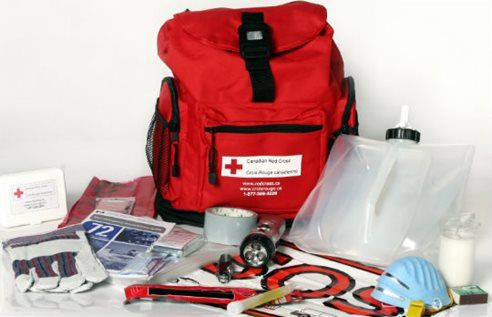 The Red Cross recommends that you keep a disaster preparedness kit in your home with enough supplies to meet your family’s needs for at least 3 days. By taking the time now to store food, water and supplies, you can provide for yourself and your family in an emergency.
The Red Cross recommends that you keep a disaster preparedness kit in your home with enough supplies to meet your family’s needs for at least 3 days. By taking the time now to store food, water and supplies, you can provide for yourself and your family in an emergency.
Building a kit might seem expensive, but it doesn’t need to be, and it is worth the effort! Download our Build or Buy a Kit list for some tips to get you started.
Watch the video: What’s inside an emergency kit?
Essential items for your Emergency kit
Here are suggested items to assemble your emergency kit at home. You can also buy Red Cross emergency kits online.
- Water
- Food (non-perishable) and manual can opener if this includes cans
- Mask(s) and hand sanitizer
- Special needs such as medications, baby needs, extra glasses, etc.
- Important family documents (i.e. copies of birth and marriage certificates, passports, licenses, wills, land deeds and insurance)
- A copy of your emergency plan
- Crank or battery-operated flashlight, with extra batteries
- Battery-operated or crank radio
- Extra keys, for your house and car
- First aid kit
- Extra cash
- Personal hygiene items
- Pet food and pet medication
- Cell phone with extra charger or battery pack
You may want to have a backpack or bag with your most important items already packed in the event you must evacuate quickly.
It is important that you check it every year and to resupply it after every use.
Additional items to consider
- Change of clothing and footwear for each person
- Plastic sheeting
- Scissors and a pocket knife
- Whistle
- Hand sanitizer
- Pet food and pet medication
- Garbage bags and twist ties
- Toilet paper
- Multi-tool or basic tools (i.e. hammer, wrench, screwdriver etc.)
- Duct tape
- Sleeping bag or warm blanket for each member of your house hold
- Toys, games, books, deck of cards
- Paper maps
- Traditional medicines and/or easily portable ceremonial items
- Traditional foods that may be difficult to find in stores
|
Vehicle emergency preparedness kit
An emergency can happen at any time when you are in your car. Be prepared to help yourself and your family if you are ever stuck in your vehicle for an extended period of time.
In addition to your emergency preparedness kit, it is recommended that you keep the following items in your car:
- Water
- Food (non-perishable)
- Blanket
- Extra clothing and shoes
- Crank or battery operated flashlight, with extra batteries
- Road maps
- Road flares
- Work gloves
- Windshield washer fluid
- Jumper cable or battery pack
- Sand, salt or kitty litter
- Shovel and ice scraper
- De-icer (methyl hydrate)
- Phone charger
|